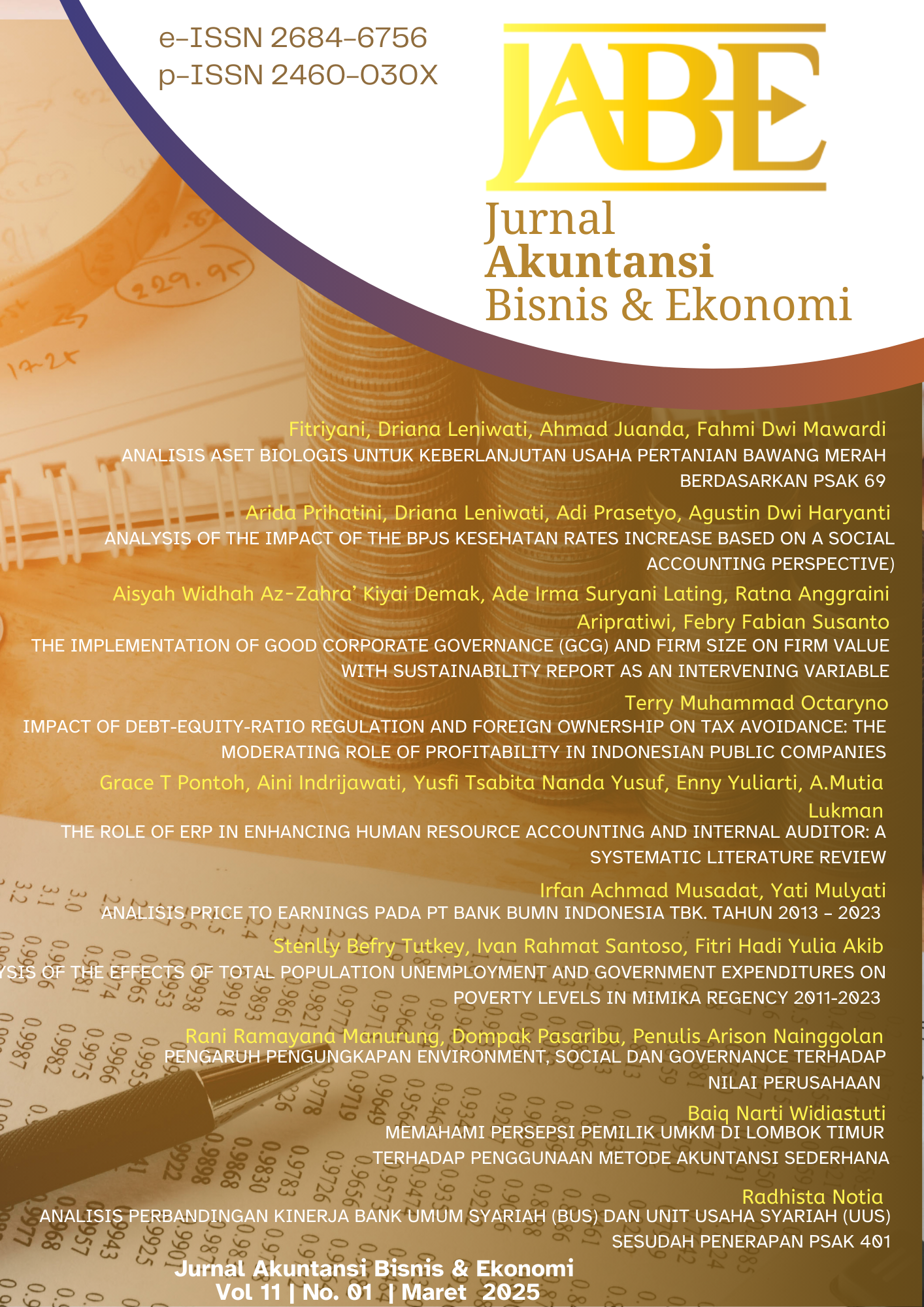Dampak Regulasi Rasio Hutang-Ekuitas dan Kepemilikan Asing terhadap Penghindaran Pajak: Peran Moderasi Profitabilitas pada Perusahaan Publik di Indonesia
DOI:
https://doi.org/10.33197/jabe.vol11.iss1.2025.2403Kata Kunci:
Penghindaran Pajak, Regulasi DER, Kepemilikan Asing, ProfitabilitasAbstrak
Penelitian ini menguji dampak regulasi rasio utang terhadap ekuitas (DER) dan kepemilikan asing terhadap penghindaran pajak pada perusahaan publik di Indonesia, dengan profitabilitas sebagai variabel moderasi. Sampel penelitian ini adalah perusahaan-perusahaan yang terdaftar di Bursa Efek Indonesia yang melaporkan laba sebelum pajak dan laba bersih yang positif dari tahun 2011 hingga 2020. Dengan menggunakan purposive sampling, set data akhir terdiri dari 104 perusahaan di enam sektor industri, yang dirata-ratakan per tahun per sektor, menghasilkan 60 titik data. Analisis data dilakukan dengan menggunakan SPSS versi 24. Temuan menunjukkan bahwa regulasi DER memiliki dampak negatif terhadap penghindaran pajak, yang menunjukkan bahwa nilai DER yang lebih tinggi menyebabkan pengawasan kreditur yang lebih besar, sehingga menghambat penghindaran pajak. Tren ini konsisten sebelum dan sesudah penerapan peraturan PMK-169/2015. Sebaliknya, kepemilikan asing berpengaruh positif terhadap penghindaran pajak, yang mengindikasikan bahwa perusahaan dengan tingkat kepemilikan asing yang lebih tinggi cenderung mengadopsi strategi penghindaran pajak. Namun, profitabilitas memoderasi secara negatif hubungan antara kepemilikan asing dan penghindaran pajak, yang mengindikasikan bahwa perusahaan yang lebih menguntungkan cenderung tidak melakukan penghindaran pajak yang agresif. Penelitian ini menggarisbawahi pentingnya regulasi DER dalam membatasi penghindaran pajak dan menyoroti profitabilitas sebagai faktor yang mengurangi penghindaran pajak di perusahaan milik asing. Keterbatasan dari penelitian ini adalah fokus penelitian pada enam sektor industri dan data tahunan, yang mungkin mengabaikan variasi antar tahun. Penelitian di masa depan dapat memperluas cakupannya dengan memasukkan sektor-sektor tambahan dan data triwulanan untuk menangkap strategi pajak jangka pendek, dan dengan memeriksa faktor-faktor moderasi lainnya, seperti ukuran perusahaan dan daya saing pasar.
Unduhan
Referensi
Ariyanti, F. (2021). 2.000 Perusahaan Asing Gelapkan Pajak Selama 10 Tahun. Retrieved from https://www.liputan6.com/bisnis/read/2469089/2000-perusahaan-asing-gelapkan-pajak-selama-10-tahun
BPS. (2024). Actual Government Expenditures (Finance) (Billion Rupiahs), 2022-2024. Retrieved from https://www.bps.go.id/en/statistics-table/2/MTA3MCMy/actual-government-revenues--billion-rupiahs-.html
Brigham, E. F. and H. J. F. (2017). Fundamentals of Financial Management: Concise, 9th Edition.
Chen, R. (2024). Multinational Tax Avoidance Associated with Leverage, Intangibility and Profitability on Non-US. Data.
Chen, S., Chen, X., Cheng, Q., & Shevlin, T. J. (2011). Are Family Firms More Tax Aggressive Than Non-Family Firms? SSRN Electronic Journal. https://doi.org/10.2139/ssrn.1014280
Christensen, T. E., Cottrell, D. M., & Budd, C. J. (2016). Advanced Financial Accounting.
CNN Indonesia. (2020). Studi: Penghindaran Pajak Rugikan Ekonomi Global Rp6.046 T. Retrieved fromhttps://www.cnnindonesia.com/ekonomi/20201120095447-532-572222/studi-penghindaran-pajak-rugikan-ekonomi-global-rp6046-t.
Darsani, P. A., & Sukartha, I. M. (2021). The Effect of Institutional Ownership, Profitability, Leverage and Capital Intensity Ratio on Tax Avoidance. In American Journal of Humanities and Social Sciences Research (Issue 5). www.ajhssr.com
Deef, A. T., Badi Alwarashdeh, & Nawaf Al-faerh. (2021). The Impact of Foreign Ownership and Managerial Ownership on Tax Avoidance: Empirical Evedence from Egypt. In Academy of Accounting and Financial Studies Journal (Vol. 25, Issue 2).
Desai, M. A., & Dharmapala, D. (2005). Corporate Tax Avoidance and Firm Value. SSRN Electronic Journal. https://doi.org/10.2139/ssrn.689562
Dom, R., Custers, A., Davenport, S., & Prichard, W. (2022). Innovations in Tax Compliance: Building Trust, Navigating Politics, and Tailoring Reform.
Duhoon, A., & Singh, M. (2023). Corporate tax avoidance: a systematic literature review and future research directions. LBS Journal of Management & Research, 21(2), 197–217. https://doi.org/10.1108/lbsjmr-12-2022-0082
Ekaristi, C. Y., Nur’aini F Purwienanti, E., & Rakhmayani, A. (2022). Analysis of the Effect of Profitability, Leverage on Tax Avoidance. In Applied International Journal.
Faradisa, F., & Fahlevi, H. (2022). Do Foreign Ownership, Profitability, and Leverage Influenece Tax Avoidance of Indonesian Mining Companies? Jurnal Ilmiah Mahasiswa Ekonomi Akuntansi, 7(4), 520–533. https://doi.org/10.24815/jimeka.v7i4.21100
Hanlon, M., & Heitzman, S. (2011). A Review of Tax Research. SSRN Electronic Journal. https://doi.org/10.2139/ssrn.1476561
Hargrave, M., & Abapo, S. R. (2023). Capital Structure Definition, Theories, & Example. https://study.com/academy/lesson/what-is-capital-structure-theory-definition-overview.html
Indriyanti, A and Pinondang Dalimunthe (2023). Profitability as a Moderator of Leverage and Firm Size on Tax Avoidance: Empirical Study at Indonesia Construction Companies. ECo-Fin, 5(3), 2023. https://doi.org/10.32877/ef
Jensen, M. C., & Meckling, W. H. (1976). Theory of the Firm: Managerial Behavior, Agency Costs and Ownership Structure. In Journal of Financial Economics (Issue 4). Harvard University Press.http://ssrn.com/abstract=94043Electroniccopyavailableat:http://ssrn.com/abstract=94043http://hupress.harvard.edu/catalog/JENTHF.html
Kompas.com. (2020). RI Diperkirakan Rugi Rp 68,7 Triliun Akibat Penghindaran Pajak. Retrieved from https://money.kompas.com/read/2020/11/23/183000126/ri-diperkirakan-rugi-rp-68-7-triliun-akibat-penghindaran-pajak?lgn_method=google&google_btn=onetap.
Mantiri, J. & W. U. (2024). Kepatuhan Pajak Perusahaan Terbuka Modal Asing Berdasarkan Laporan Keuangan Wajib Pajak. Indonesian Treasury Review
mediaindonesia.com. (2016). Perusahaan Mengaku Rugi tapi Terus Ekspansi. Retrieved from https://mediaindonesia.com/megapolitan/42193/perusahaan-mengaku-rugi-tapi-terus-ekspansi-1
Menkeu RI. (2015). PMK 169 Tahun 2015. www.jdih.kemenkeu.go.id
Mu’minah, L. L., Kristiana, I., & Hanum, A. N. (2023). The Role of Profitability in Moderating Political Connections, Corporate Risk, Leverage, And Firm Size to Tax Avoidance. Journal of Accounting Science, 7(1), 28–41. https://doi.org/10.21070/jas.v7i1.1681
Muhajirin, M. Y., Junaid, A., Arif, M., & Pramukti, A. (2021). Pengaruh Transfer Pricing dan Kepemilikan Asing Terhadap Tax Avodance Pada Perusahaan Manufaktur yang Terdaftar di Bursa Efek Indonesia (BEI). In Center of Economic Student Journal (Vol. 4, Issue 2).
Nafisah, K. (2016). Analisis Hukum tentang Kepemilikan Saham Asing. https://doi.org/10.12345/ius.v4i2.337
OECD. (2017). Limiting Base Erosion Involving Interest Deductions and Other Financial Payments, Action 4 - 2016 Update. OECD. https://doi.org/10.1787/9789264268333-en
OECD. (2024). Tax-to-GDP ratio. http://www.oecd.org/tax/tax-policy/oecd-classification-taxes-interpretative-guide.pdf
Olanisebe, Hannatu Sabo, Ahmad M, & Liman Muhammas M. (2023). Intitutional Ownership and Tax Avoidance of Listed Companies in Nigeria: The Mediating Effect of Profitability. In Fuoye. Journal of Accounting and Management (Vol. 6). https://www.firs.gov.ng/tax-statistics-report/
Ozili, P. K. (2023). The acceptable R-square in empirical modelling for social science research. Online at https://mpra.ub.uni-muenchen.de/115769/. MPRA Paper No. 115769, 26 Dec 2022
Prabowo, I. C. (2020). Capital Structure, Profitability, Firm Size and Corporate Tax Avoidance: Evidence from Indonesia Palm Oil Companies. Business Economic, Communication, and Social Science.
ProConsult. (2023). Kasus Penghindaran pajak perusahaan di Indonesia. Retrieved from https://proconsult.id/kasus-penghindaraan-pajak/
Pujiningsih, S., & Salsabyla, N. A. (2022). Relationship of Foreign Institutional Ownership and Management Incentives to Tax Avoidance. Jurnal Akuntansi Dan Keuangan Indonesia, 19(2), 244–262. https://doi.org/10.21002/jaki.2022.12
Rahayu, P., Suaidah, I., & Wahyuni, S. D. (2024). Can Foreign Ownership and Leverage Affect Tax Avoidance. Journal of Economics, Finance and Management Studies. https://doi.org/10.47191/jefms/v7-i4-43
Rahman, A., & Muktadir, Md. G. (2021). SPSS: An Imperative Quantitative Data Analysis Tool for Social Science Research. International Journal of Research and Innovation in Social Science, 05(10), 300–302. https://doi.org/10.47772/ijriss.2021.51012
Rego, S. Olhoft and, Wilson, R. (2012). Equity Risk Incentives and Corporate Tax Aggressiveness. In Journal of Accounting Research.
Riyanto, E. (2016). Indonesia’s new Thin Capitalisation rules. https://www.taxand.com/wp-content/uploads/2017/09/indonesias_new_thin_capitalisation_rules-1.pdf
Satyadini, A. E., Rea Erlangga, R., & Vdkg, B. S. (2019). Who Avoids Taxes? An Empirical Evidence from The Case of Indonesia.
Sekaran, U., & Bougie, R. (2016). Research Methods for Business. www.wileypluslearningspace.com
Shubita, M. F. (2024). The relationship between sales growth, profitability, and tax avoidance. Innovative Marketing, 20(1), 113–121. https://doi.org/10.21511/im.20(1).2024.10
Susilawati, E., & Tarmidi, D. (2024). The Influence of Institutional Ownership and Foreign Ownership on Tax Avoidance with Audit Quality as a Moderation Variable. Asian Journal of Economics, Business and Accounting, 24(5), 1–11. https://doi.org/10.9734/ajeba/2024/v24i51286
Tax Justice Network. (2023). State of Tax Justice 2023. https://taxjustice.net/reports/the-state-of-tax-justice-2023/
Wahlen, J. M.. Stephen Baginski, Mark Bradshaw. (2023). Financial Reporting, Financial Statement Analysis, and Valuation, 10e. Cengage Learning, Inc. ISBN:978-0-357-72209-1
Yustia, L., & Khomsiyah, K. (2024). Pengaruh Kepemilikan Asing, Direktur dan Komisaris Asing Terhadap Penghindaran Pajak dimoderasi oleh Profitabilitas. Ekonomis: Journal of Economics and Business, 8(1), 390. https://doi.org/10.33087/ekonomis.v8i1.1437
Zahwa Arinditya Putri, M., Mudzakir, A., & Islam, U. (2024). Pengaruh Return on Assets (ROA) dan Current Ratio (CR) terhadap Cash Effective Tax rate (CETR) pad Perusahaan yang Terfadftar di Indeks Saham Syariah Indonesia (ISSI) (Studi di PT Harum Energy Tbk Periode 2013-2022). https://doi.org/10.46306/vls.v4i2
Zarkasih, E. N., & Maryati, M. (2023). Pengaruh Profitabilitas, Transfer Pricing, dan Kepemilikan Asing Terhadap Tax Avoidance. Ratio: Reviu Akuntansi Kontemporer Indonesia, 4(1). https://doi.org/10.30595/ratio.v4i1.15567
Unduhan
Diterbitkan
Cara Mengutip
Terbitan
Bagian
Lisensi
Hak Cipta (c) 2025 Terry Octaryno

Artikel ini berlisensiCreative Commons Attribution-NonCommercial-ShareAlike 4.0 International License.
Submission of a manuscript implies that the submitted work has not been published before (except as part of a thesis or report, or abstract); that it is not under consideration for publication elsewhere; that its publication has been approved by all co-authors. If and when the manuscript is accepted for publication, the author(s) still hold the copyright and retain publishing rights without restrictions. Authors or others are allowed to multiply the article as long as not for commercial purposes. For the new invention, authors are suggested to manage its patent before published. The license type is CC-BY-SA 4.0.












